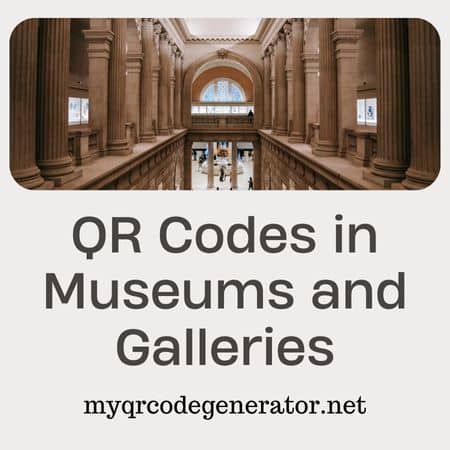In recent years, museums and galleries have been undergoing a digital transformation, embracing new technologies to enhance visitor experiences. One such technology that has gained significant traction is the use of QR codes. These two-dimensional barcodes serve as a gateway to a wealth of information and interactive content, revolutionizing the way visitors engage with exhibits. This article delves into the role of QR codes in museums and galleries, exploring their benefits, applications, and future potential.

The Digital Evolution in Museums and Galleries
From Traditional to Interactive Exhibits
Gone are the days when museums and galleries were solely about viewing artifacts and artworks in glass cases. The digital age has ushered in interactive exhibits that encourage visitor participation and engagement. Touchscreens, virtual reality stations, and mobile apps are becoming commonplace, but QR codes have emerged as a particularly effective tool in this digital evolution.
Role of QR Codes in Digital Transformation
QR codes act as a bridge between the physical exhibit and digital information. By simply scanning a code with their smartphones, visitors can access a variety of content, from historical context to artist interviews. This seamless integration of digital elements enriches the visitor experience, making it more informative and engaging.
Advantages of Utilizing QR Codes
Enhanced Visitor Engagement
QR codes offer an interactive layer to traditional exhibits. Whether it's an audio guide for a historical artifact or a video demonstration of an art technique, QR codes provide additional avenues for engagement, making the visit more memorable and educational.
Cost-Effective Information Sharing
Printing and distributing physical brochures or audio guide devices can be costly and logistically challenging. QR codes, on the other hand, are a cost-effective solution. They can be easily generated and incorporated into existing exhibit labels, reducing both printing costs and waste.
Real-Time Analytics and Visitor Feedback
One of the most significant advantages of using QR codes is the ability to collect real-time data. Museums and galleries can track which exhibits are most engaging, how long visitors interact with digital content, and even gather direct feedback through linked surveys. This data is invaluable for making informed decisions and optimizing future exhibits.
Types of Content Delivered via QR Codes
Audio Tours and Narratives
QR codes can link to audio guides that provide rich narratives about the exhibit. This is especially useful for visitors who prefer an auditory experience or for those with visual impairments.
Video Demonstrations
For more complex exhibits or artworks that involve movement or transformation, video demonstrations can be invaluable. Scanning a QR code can lead visitors to a video that shows the exhibit in action or provides a detailed explanation.
Extended Reading and Contextual Information
For those who want to dive deeper, QR codes can link to articles, research papers, or additional resources that provide more context and information about the exhibit.
Challenges and Effective Practices
User Experience Considerations
While QR codes offer a plethora of benefits, poor implementation can hinder the user experience. Ensure that QR codes are easily accessible and that the linked content is mobile-friendly.
Data Privacy and Security Measures
Given that QR codes can collect user data, it's crucial to adhere to privacy regulations and ensure that the data is securely stored and managed.
A/B Testing and Performance Optimization
To maximize engagement, it's advisable to perform A/B tests on different types of content and QR code placements. This data-driven approach allows for continual optimization of the visitor experience.
The Future of QR Codes in Museums and Galleries
Augmented Reality and Virtual Experiences
The next frontier for QR codes is likely to involve augmented reality. Imagine scanning a QR code next to a historical artifact and seeing a 3D hologram providing a real-world context for that item.
Integration with Mobile Apps and Smart Devices
As smart technology continues to evolve, QR codes could integrate more seamlessly with mobile apps and even wearable devices, offering a more personalized and immersive experience.
Personalized Visitor Experiences
Future QR codes could offer personalized tours or content based on the visitor's previous interactions, enhancing the educational value and overall enjoyment of the museum or gallery visit.
Real-World Examples: QR Codes in Action
Art Museums
The Louvre in Paris has successfully implemented QR codes next to iconic pieces like the Mona Lisa, allowing visitors to delve into the history, techniques, and controversies surrounding the artwork.
Historical Museums
The National Museum of American History in Washington, D.C., uses QR codes to provide visitors with timelines, archival photos, and oral histories related to the exhibits, enriching the educational experience.
Science and Technology Centers
The Exploratorium in San Francisco employs QR codes to link to interactive experiments and demonstrations, enabling visitors to engage with scientific concepts in a hands-on manner.
Conclusion
QR codes have proven to be a transformative element in the realm of museums and galleries. They offer a seamless way to enhance visitor engagement, provide educational value, and even gather real-time analytics for future improvements. From art and history to science and technology, various types of institutions are harnessing the power of QR codes to offer enriched, interactive experiences. As technology continues to advance, the role of QR codes is set to evolve, promising even more innovative and personalized ways to explore and appreciate the world of art, history, and science. Whether you're a curator, a museum-goer, or simply someone interested in the intersection of technology and culture, the integration of QR codes in museums and galleries represents a significant stride toward a more interactive and enriching future.